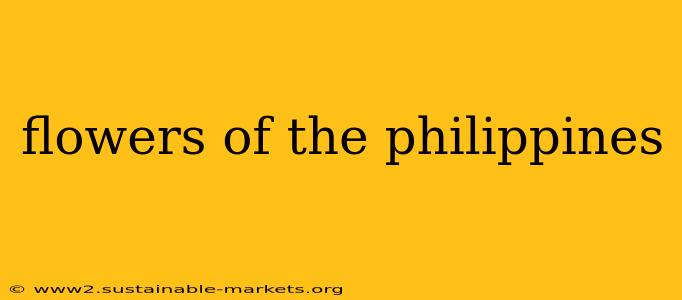The Philippines, an archipelago of over 7,000 islands, boasts an incredibly diverse array of flora, including a stunning variety of flowers. From delicate orchids to vibrant hibiscus, the Philippine landscape is a breathtaking display of color and beauty. This exploration delves into some of the most iconic and captivating flowers found in this Southeast Asian gem. We'll discover their significance, unique characteristics, and the role they play in the rich cultural heritage of the Philippines.
National Flower: Sampaguita (Jasminum sambac)
The Sampaguita reigns supreme as the national flower of the Philippines. Its delicate, star-shaped white blossoms exude a captivating fragrance, filling the air with a sweet, intoxicating aroma. More than just a beautiful flower, the Sampaguita holds deep cultural significance. It is often used in leis, adorning guests and participants in celebrations and festivals. The enduring fragrance is associated with purity, respect, and love, making it a ubiquitous symbol throughout the Philippines. Its versatility extends beyond adornment; the flowers are also used in perfumes, teas, and even traditional medicine.
Beyond Sampaguita: Exploring the Diverse Floral Landscape
While the Sampaguita holds a special place in the hearts of Filipinos, the country's floral tapestry extends far beyond this iconic bloom. Let's explore some other noteworthy flowers:
Orchids: A Paradisiacal Abundance
The Philippines is a haven for orchid enthusiasts. Numerous species thrive in the country's diverse ecosystems, ranging from terrestrial orchids found in forests to epiphytic orchids clinging to tree branches. Their intricate forms and varied colors make them a captivating subject for botanists and flower lovers alike. Some notable Philippine orchids include the Dendrobium, Phalaenopsis, and Vanda species, each possessing unique beauty and charm.
Hibiscus (Hibiscus rosa-sinensis): A Symbol of Tropical Beauty
The vibrant Hibiscus, with its large, showy blossoms in various colors, is another common sight in the Philippines. These flowers are not only visually stunning but also hold practical uses. Certain Hibiscus species are used in traditional medicine, while others are cultivated for their edible flowers and leaves. The hibiscus is often associated with beauty, vibrancy, and tropical paradise.
Waling-Waling (Vanda sanderiana): The Queen of Philippine Orchids
Considered the "Queen of Philippine Orchids," the Waling-Waling is a majestic orchid known for its large, striking flowers. Its vibrant colors and intricate patterns make it a highly prized species, both for its aesthetic value and its significance in the country's floral heritage. Unfortunately, due to habitat loss and over-collection, the Waling-Waling is now considered a threatened species, highlighting the importance of conservation efforts.
Other Notable Philippine Flowers:
- Dama de Noche (Cestrum nocturnum): Known for its intensely fragrant blossoms that release their aroma at night.
- Bougainvillea: A vibrant climber with colorful bracts that often adorn fences, walls, and gardens throughout the country.
- Rose: While not native, roses are widely cultivated in the Philippines and hold symbolic meaning, particularly in romantic contexts.
The Cultural Significance of Flowers in the Philippines
Flowers are deeply intertwined with the cultural fabric of the Philippines. They play a significant role in various celebrations, religious ceremonies, and everyday life. From adorning churches during religious festivities to gracing special occasions such as weddings and birthdays, flowers add a layer of beauty and significance to Filipino culture.
Conclusion: A Floral Heritage to Cherish
The flowers of the Philippines represent a rich and diverse natural heritage. Their beauty, fragrance, and cultural significance contribute significantly to the country’s identity. Preserving this floral biodiversity is crucial, not only for the aesthetic value but also for the preservation of the unique cultural heritage intertwined with these remarkable blooms. Further exploration into the myriad species found throughout the archipelago is an ongoing journey of discovery for botanists and flower lovers alike.

